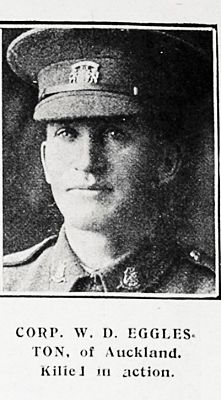WW1 Sergeant William Dobson Eggleston (25993)
William Dobson Eggleston (25993) was born 19 March 1887 in Sunderland, England, the elder son of Mrs J. C. (Jane Cole) Eggleston.
The family moved to Dunelm, 17 Seaview Road, Remuera and later Domett Avenue, Epsom, Auckland. [1] Whilst he was in England, William was a volunteer in the 3rd Durham Light Infantry. Arriving in New Zealand, William was interested in the game of golf, and in 1913 he played in the golf tournament for the R. O. Gardner Cup, at the Maungakiekie Club. In October 1909, the Auckland Golf Club, was renamed the Maungakiekie Club, and moved to its current position at Mt Roskill, Auckland from the land adjacent to Cornwall Park and Titirangi. [2]. Maungakiekie can be translated as meaning “the hill of a kiekie vine”- ‘Maunga’ meaning a mountain or hill and ‘Kiekie’ being a vine. [3] When he enlisted on 27 May 1916 at Trentham, William was working as an accountant for the North Auckland Farmers Union in Whangarei. At that time, William’s sister, Edith Eggleston, was living in Waterloo Road, Lower Hutt, Wellington. He was described as 5ft 8 3/4 inches tall with blue eyes and dark brown hair and was promoted on the 3 September 1916 from Corporal to Sergeant.
He embarked on 15 November 1916 with the 19th Reinforcements, J Company, New Zealand Expeditionary Force and was subsequently transferred to the New Zealand Rifle Brigade, 4th Battalion. He was a musketry instructor at Sling Camp, in England, then was transferred to France in December 1917. His younger brother, Samuel Cole Eggleston (14596) had enlisted with the 14th reinforcements and was also on active service in France [4]
In France on 21 March 1918, the Germans had begun the Spring Offensive called Operation Michael, to break the Allied lines. The New Zealand and British divisions, fighting in the same part of the Somme as they had been in 1916, had managed to stabilise the front in this sector. On 26 March 1918 two composite brigades pushed forward until they clashed with the advancing enemy formations between the towns of Auchonvillers and Hamel; next morning another composite brigade moved into position between the towns of Colincamps and Hébuterne and had repelled a series of German attacks. By this time, Operation Michael, now into its seventh day, was running out of steam as German losses mounted. Even as the New Zealanders entered the line, the German offensive was defeated. The New Zealand Division’s 10-day effort had cost some 2,400 casualties, with more than 500 dead, including William Dobson Eggleston (25993) who was killed in action on 30 March 1918 in the fields of the Somme, France and is buried at Grevillers (New Zealand) Memorial, Grevillers British Cemetery, Pas-de-Calais, France. [5] William was awarded the British War Medal (1914-1920) and the Victory Medal.
Samuel Cole (14596)
Samuel Cole Eggleston (14569), William’s brother, had embarked for Europe on 26 June 1916 as a Lance Corporal with the 14th Reinforcements, Wellington Infantry Battalion, B Company, with the New Zealand Expeditionary Force. At that time, he was a clerk working for the meat works, Thomas Borthwick and Sons in Waitara, Taranaki, and described as being 5ft 5 ½ inches tall, with dark brown hair and blue eyes [6]
He fought on the Western Front in France from June 1917 to October 1918, where he was wounded on 18 June 1917, and was transferred back to the front two weeks later. In November 1918, he was hospitalised with trench fever or ‘pyrexia’ which, caused shooting pains in the shins followed by very high fever, totally incapacitating a person. [7] One soldier explains the problems he had with the trench fever-causing lice, on the Western Front: “The lice were the size of grains of rice, each with its own bite, each with its own itch. When we could, we would run hot wax from a candle down the seams of our trousers, our vests – whatever you had – to burn them out. It was the only thing to do. Eventually, when we reached Rouen, they took every stitch off us and gave us a suit of sterilised blue material. And the uniforms they took off – they burned them – to get rid of the lice.” Simpkin, John, Spartacus Educational [8] Samuel sailed back to New Zealand in March 1919 and was discharged on 13 May 1919. He was awarded the British War Medal and the Victory Medal. He died in Auckland on 2 February 1959.
